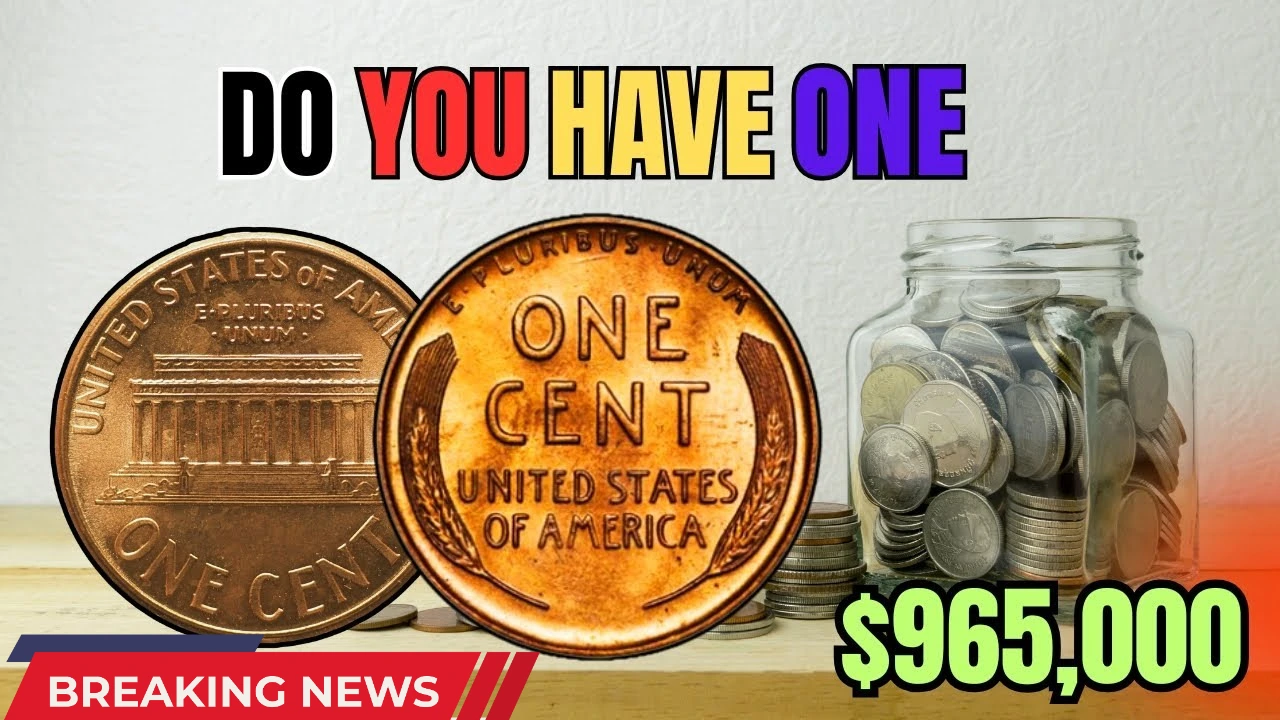Imagine finding a small, old penny in your pocket and learning it could be worth thousands, or even millions, of dollars. That’s exactly what is happening with the Lincoln Wheat Penny. This simple coin, minted in the United States for nearly 50 years, has become a treasure for collectors and investors. The Lincoln Wheat Penny is not just a piece of history; it’s a coin that can turn ordinary people into rich collectors overnight.
The Lincoln Wheat Penny was first made in 1909 to celebrate the 100th birthday of President Abraham Lincoln. It is easy to recognize because of the two wheat stalks on the back, which is why it is called the “Wheat Penny.” While most Wheat Pennies are common and worth only a few cents, some rare versions are highly valuable. Factors like the year it was made, the mint mark, and its condition can make a huge difference in its value.
In recent years, stories about rare Lincoln Wheat Pennies selling for hundreds of thousands or even millions of dollars have made headlines. Some collectors have become rich by finding these rare coins in old coin collections or even in everyday change. This article will explain everything you need to know about the Lincoln Wheat Penny, how to spot a valuable one, and why it has quietly made so many collectors rich.
Lincoln Wheat Penny: Rare Coin Riches
The Lincoln Wheat Penny is one of the most famous coins in American history. It was made from 1909 to 1958 and is loved by collectors for its simple design and historical importance. The coin features a portrait of Abraham Lincoln on the front and two wheat stalks on the back. While most Wheat Pennies are common, some rare ones can be worth a fortune.
| Feature | Details |
|---|---|
| Years Minted | 1909–1958 |
| Design | Abraham Lincoln (front), Wheat stalks (back) |
| Composition | 95% copper, 5% tin and zinc (except 1943: zinc-coated steel) |
| Mint Marks | P (Philadelphia), D (Denver), S (San Francisco) |
| Value (Most Coins) | 1 cent (face value) |
| Value (Rare Coins) | Up to $100,000 or more for key dates and errors |
| Most Valuable Variants | 1909-S VDB, 1943 Copper, 1914-D, 1944 Steel, 1955 Doubled Die |
| Key Factors | Year, mint mark, condition, errors |
History and Design of the Lincoln Wheat Penny
The Lincoln Wheat Penny was introduced in 1909 to celebrate the 100th anniversary of Abraham Lincoln’s birth. It was the first U.S. coin to feature a real person—President Lincoln—on the front. The back of the coin has two wheat stalks, which is why it is called the Wheat Penny. The designer, Victor David Brenner, included his initials “VDB” on the back of some early coins, making those versions especially valuable.
The coin was made in large numbers every year at three main mints: Philadelphia (P), Denver (D), and San Francisco (S). The mint mark, a small letter under the date, tells you where the coin was made. Most Wheat Pennies are made of 95% copper and 5% tin and zinc, but in 1943, because of a shortage of copper during World War II, the coins were made of zinc-coated steel.
Why Some Lincoln Wheat Pennies Are Worth So Much
Most Lincoln Wheat Pennies are worth only a few cents, but some are worth a lot of money. The value of a Wheat Penny depends on several factors:
- Year and Mint Mark: Some years and mint marks are much rarer than others. For example, the 1909-S VDB and 1914-D are famous for their low mintage and high value.
- Condition (Grade): Coins in perfect, uncirculated condition are worth much more than coins that are worn or damaged.
- Errors and Varieties: Coins with mistakes, like double stamps or off-center designs, can be very valuable.
- Metal Content: The 1943 copper penny is extremely rare and valuable because most 1943 pennies were made of steel.
Statistical Data:
Over 35 billion Lincoln Wheat Pennies were made from 1909 to 1958. Most are worth only a few cents, but some rare coins can sell for $10,000, $100,000, or even more. The 1943-D Bronze Cent once sold for $840,000 at auction. The 1909-S VDB is also highly valuable, with some coins selling for over $150,000.
Most Valuable Lincoln Wheat Pennies
Here are some of the most valuable Lincoln Wheat Pennies that collectors look for:
- 1909-S VDB: This is the rarest and most famous Wheat Penny. It was made in San Francisco and has the designer’s initials (VDB) on the back. Only a few hundred thousand were made, and today, a high-grade example can sell for over $150,000.
- 1943 Copper Penny: Most 1943 pennies are made of steel, but a few were accidentally made of copper. These are extremely rare and can be worth hundreds of thousands of dollars. One sold for $840,000 at auction.
- 1914-D: This coin was made in Denver and is rare because only a little over a million were produced. It can be worth thousands of dollars.
- 1944 Steel Penny: Most 1944 pennies are copper, but a few were made of steel by mistake. These are very rare and valuable.
- 1955 Doubled Die: This coin has a double stamp error, making it look blurry. It is highly collectible and can be worth thousands of dollars7.
- Other Key Dates: 1915-S, 1922 No D, and 1931-S are also rare and valuable.
How to Spot a Valuable Lincoln Wheat Penny
If you want to find a valuable Lincoln Wheat Penny, here are some tips:
- Check the Year and Mint Mark: Look for coins from rare years and mints, like 1909-S VDB, 1914-D, and 1943 copper.
- Look for Errors: Check for double stamps, off-center designs, or missing mint marks.
- Check the Condition: Coins in perfect, uncirculated condition are worth much more.
- Use a Magnifying Glass: Some errors are very small and hard to see with the naked eye.
Coin Grading and Condition
The condition of a Lincoln Wheat Penny is very important for its value. Coins are graded on a scale from Poor (PO-1) to Uncirculated (MS-60+). A coin in Uncirculated condition has no wear and looks like it just came from the mint. These coins are worth the most money.
- Poor (PO-1): Heavily worn, barely legible.
- Good (G-4): Worn, but details are visible.
- Fine (F-12): Moderate wear, details are clear.
- Uncirculated (MS-60+): No wear, original shine.
Market Demand and Trends
The value of Lincoln Wheat Pennies changes over time based on market demand and collector interest. Rare coins with low mintage or unique errors are always in demand. Sometimes, news stories or auctions can cause prices to go up quickly.
Statistical Data:
In 2025, the most valuable Lincoln Wheat Pennies can sell for $100,000 or more if they are in perfect condition or have rare errors. The average value of most Wheat Pennies is 5 to 50 cents, but rare ones can be worth thousands or even hundreds of thousands of dollars.
How to Sell Your Lincoln Wheat Penny
If you think you have a valuable Lincoln Wheat Penny, here are some ways to sell it:
- Online Auctions: Websites like eBay are popular for selling coins.
- Coin Dealers: Local coin shops or dealers can give you a fair price.
- Coin Shows: These events are a great place to meet collectors and dealers.
- Pawn Shops: Some pawn shops buy coins, but you may not get the best price.
It is important to get your coin graded by a professional grading service if you think it is rare or valuable. This will help you get the best price when you sell it.
Common Myths and Misunderstandings
There are many myths about the Lincoln Wheat Penny. Here are some common ones and the real facts:
- Myth: All Lincoln Wheat Pennies are worth a lot of money.
- Fact: Most are worth only a few cents. Only rare dates, mint marks, or errors are valuable.
- Myth: You can find rare Wheat Pennies in everyday change.
- Fact: Most rare coins are already in collectors’ hands, but it is still possible to find valuable coins in old collections or coin rolls.
- Myth: Any 1943 penny is valuable.
- Fact: Only the rare 1943 copper penny is valuable. Most 1943 pennies are steel and worth only a few cents.
How to Start Collecting Lincoln Wheat Pennies
Collecting Lincoln Wheat Pennies is a fun and rewarding hobby. Here are some tips to get started:
- Start Small: You don’t need a lot of money to begin collecting. Start with common coins and learn how to spot rare ones.
- Learn About Key Dates and Errors: Knowing which coins are rare will help you find valuable ones.
- Join a Coin Club: Talking to other collectors can help you learn more and find rare coins.
- Buy a Coin Book: There are many books and guides that explain how to identify and value Wheat Pennies.
- Check Your Change: You never know when you might find a rare coin in your pocket.
Statistical Data and Interesting Facts
- Years Minted: 1909–1958 (50 years)
- Total Minted: Over 35 billion coins
- Most Valuable Coin: 1943-D Bronze Cent sold for $840,000 at auction
- Other Valuable Coins: 1909-S VDB, 1914-D, 1944 Steel, 1955 Doubled Die
- Average Value: Most Wheat Pennies are worth 5 to 50 cents
- Rare Coin Value: Some rare coins can be worth $10,000, $100,000, or even more
- Composition: 95% copper, 5% tin and zinc (except 1943: zinc-coated steel)
- Mint Marks: P (Philadelphia), D (Denver), S (San Francisco)
Interesting Fact:
More than half a million Lincoln Wheat Pennies are still in circulation today, but most are common and worth only a few cents. However, rare coins can still be found if you know what to look for.
Bullet Points: Key Features of Lincoln Wheat Penny
- Minted from 1909 to 1958
- Features Abraham Lincoln on the front, wheat stalks on the back
- Made of 95% copper, 5% tin and zinc (except 1943: steel)
- Mint marks: P (Philadelphia), D (Denver), S (San Francisco)
- Most coins are worth 5 to 50 cents
- Rare coins can be worth thousands or even hundreds of thousands of dollars
- Key dates: 1909-S VDB, 1914-D, 1943 Copper, 1944 Steel, 1955 Doubled Die
- Condition is very important for value
- Errors and varieties can increase value
- Still possible to find rare coins in old collections or coin rolls
Conclusion
The Lincoln Wheat Penny is a small coin with a big story. While most are worth only a few cents, some rare versions can make collectors rich. The key to finding a valuable Wheat Penny is knowing the year, mint mark, condition, and errors. With over 35 billion coins made, there are still rare treasures waiting to be found.
Collecting Lincoln Wheat Pennies is a fun and exciting hobby that can also be profitable. Whether you are a beginner or an experienced collector, there is always a chance to find a rare coin that could be worth a fortune. So, the next time you find an old penny in your pocket, take a closer look—it might just be the one that quietly makes you rich.








